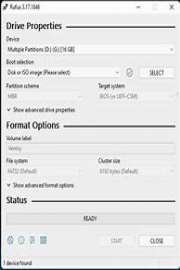Uncategorized
Rufus download

Free Open Source Bootable USB Utility Pete Batard originally released Rufus in 2011 as a free open source USB flash drive boot tool for DOS, replacing the HP Windows USB Disk Storage Format Tool (HUDSFT). Various updates have appeared over the years, and in 2020 a more modern and stable version appeared than the previous one. The most notable changes were updates to ISO image support, UEFI boot, and Windows To is Rufus? Rufus formats USB flash drives so you can boot a computer that is missing or has a damaged operating system (OS). Creates installation files from bootable ISOs, specifically for operating systems such as Linux, UEFI, and Microsoft Windows. You can also use it to update the BIOS or other DOS (function() { (‘review-app-page-desktop’); }); it used to be common practice to burn ISO images to CD using popular tools like InfraRecorder or CDBurnerXP. As technology advances, Pete Batard decided to create a USB installer when he got tired of proprietary software. HUDSFT had some limited functionality, so he took on the challenge of developing a software clone that could offer reviews praising the benefits of using Rufus as a USB flash drive boot utility. One of the most important aspects is constant updates that help ensure that the software keeps up with modern requirements. Here is a short list of the different versions that offer support for the following systems and: :ISO: Updated support for MS-DOS and : :Language :Windows For :Compatibility for Windows Vista and XP computers How do I create a Rufus drive from Begin? Before creating the Rufus USB installer, there are a few requirements that need to be met. At the top of that list is getting the ISO for the operating system you want to use, like Windows 7 or 10. If you claim it via download, you need to make sure it’s safe and free of malware or that it works. I SO. image, you will need the latest version of Rufus and a USB flash drive. Once the prerequisites are met, you can insert the external drive into the computer and run the software program. Rufus will automatically detect if a USB is present, so you won’t have to search by simply going to the boot selection dropdown and selecting the drive or ISO image. To the right of the tabs, you must click Select to open Windows Explorer. You will need to find your ISO images and open them so that Rufus knows which image you may notice there is a Download option when you click Select. The latest version of Rufus provides you with files for Windows 8 and 10 in case you can’t find one. It will ask you which one you want to download, allowing you to continue the process when you’re outside of your standard Windows installation of choice, Rufus will determine the correct partition scheme for your computer. You will need to create a volume label and decide if you want to change the default cluster size and file system settings. After clicking the Start button, the software will start creating the USB. During the creation process, an error message may appear stating that the flash drive is notlarge enough. In this situation, it is better to purchase a USB with more storage space. You will also need to format the first drive to remove the files you tried to start Windows 10 from the USB drive. With the latest updates, Rufus can start Windows 10 directly from a USB drive. You will need to purchase the appropriate license first to avoid any legal action or copyright issues from Microsoft. When you are ready to change the operating system, you can insert the flash drive into the computer, press and hold, or press the correct combination of keys to change the boot location. It may instruct you to use a USB flash drive to boot and guide you through setting up Windows 10. The operating system will run a little slower from the flash drive because there are fewer resources to rely on than on a computer . Does Rufus create a multiboot USB? There is also a caveat that there are no plans to update the software to include multi-system work. With a bit of modification though, that doesn’t mean it can’t be done, you’ll need a second, larger flash drive to act as a multiboot USB. You can follow the same steps above to create a bootable USB via Rufus and then copy the ISO files to the multiboot drive. When you’re done, simply reinsert the Rufus USB stick, choose a different operating system, and watch the software format the drive in preparation for the new operating system. Can you copy the new files on your multiboot drive to separate software? Is it better to create a bootable USB? One of Rufuss’s main competitors is UNetbootin. If you judge these two programs by reviews alone, Rufus is the most widely used tool for USB flash drives worldwide, while UNetbootin ranks 9th on the list. The main reason for this preference is that Rufus will automatically recognize your flash drive, reducing the risk of accidentally reformatting your computers and creating a new USB OS installer. While the Rufus process may seem complicated at first, it gets easier with practice. You can use the software to create multiboot media on another drive that offers faster speed and has more space. If you can’t start your computer or your operating system is corrupted, use Rufus to create a portable bootable system.
|
Votes |
